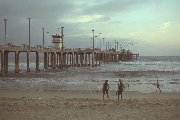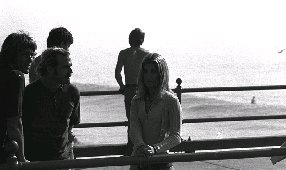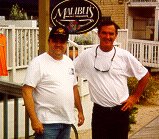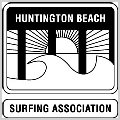Surfing Culture in Huntington Beach
A Short Paper by
Chris Gravell
December 1999
Huntington's History
For many people surfing is not just a sport, but a way of life. Surfing
originated in Hawaii, where it was known as the "sport of Kings."
"Recent archeological findings suggest that Hawaii was settled around
AD 500 . . . and perhaps after a few hundred years of riding Hawaii's
waves the uniquely Hawaiian form of the sport was developed. A cautious
guess would then set Hawaiian surfing close to 1,000 years old" (Finney
pp.23). Surfing was brought to California in 1910. Henry Huntington,
trying to get more people to come to Redondo Beach via the Pacific
Electric Railway, hired George Freeth, an experienced surfer from
Hawaii, to give demonstrations of this ancient Polynesian sport.
Surfing moved down the coast from there and came to Huntington Beach in
1920.
Huntington Beach was founded in 1902 by a group of farmers and
investors and was originally called "Pacific City." Pacific City didn't
really catch on and soon the land was sold to a Los Angeles investment
group that included Pacific Electric Railway magnate, Henry E.
Huntington. On July 4, 1904 Huntington expanded The Pacific Electric to
coastal Orange County and the name was changed from Pacific City to
Huntington Beach. The city was incorporated in 1909. In an attempt to
draw tourists to the new city, beach facilities and a pier were
constructed in 1914. Huntington Beach's economic future was assured in
1920 when oil was discovered near Goldenwest and Clay Streets, just
west of downtown. The oil pumps became the symbol of the beachfront of
Huntington Beach for many years. As the oil continued to flow
Huntington Beach became increasingly dependent on the petroleum
industry and the beach recreation business. The building of Pacific
Coast Highway in 1926, and, in 1930, the development of 8.5 miles of
city and state beaches made Huntington Beach one of the most popular
stops for tourists on their way to Mexico. In 1955 the elements of a
"surfing culture" began to develop with the founding of "Gordie's Surf
Boards," the first surf shop.
Huntington's Surfing Culture
Surfing can be said to have its own culture, given the evidence
that it has its own language, customs, and style of dress. Nowhere has
this been more self-evident that in Huntington Beach. Surf culture has
developed since the 1950's to become one of the most recognizable
symbols of Huntington Beach. To those people that had the privilege to
grow up there, surfing is just an accepted reality, it is not something
they think about, but something they feel. The sub-culture of surfing
has seen many changes over the years in board design and general
attitudes. Surfers have become more politically aware and have shown
this with national organizations, such as the Surfrider Foundation, and
in Huntington Beach, with their arguments over pier usage with the
city. These things all help to contribute to identity if the surf
culture in Huntington Beach, a culture that has been a driving force in
the city since the mid-fifties.
 Huntington Beach
is constantly a draw for new surfers. Dr. Bruce Gabrielson credits the
pier as being one of the major factors in the development of the
surfing culture, because it creates "a quality wave that allows a
"central" meeting point for the growth and development of many of the
worlds best surfers" (Gabrielson 12/7/99). Huntington Beach has gone
through many cosmetic changes, yet the surfing culture has remained a
constant and has intertwined itself with the city. Most of these
changes have gone on downtown. Downtown used to have forty-seven surf
shops, the most notable of which was Jack's Surfboards, which is still
located there today, and a collection of small businesses. Major
landmarks included the Greyhound Bus Station, The Surf Theater, and the
"Golden Bear" Nightclub. Back then, though it was a seedier place that
had many drunks and litter on the street and beach, surfers were still
drawn to the huge swells of the pier.
Huntington Beach
is constantly a draw for new surfers. Dr. Bruce Gabrielson credits the
pier as being one of the major factors in the development of the
surfing culture, because it creates "a quality wave that allows a
"central" meeting point for the growth and development of many of the
worlds best surfers" (Gabrielson 12/7/99). Huntington Beach has gone
through many cosmetic changes, yet the surfing culture has remained a
constant and has intertwined itself with the city. Most of these
changes have gone on downtown. Downtown used to have forty-seven surf
shops, the most notable of which was Jack's Surfboards, which is still
located there today, and a collection of small businesses. Major
landmarks included the Greyhound Bus Station, The Surf Theater, and the
"Golden Bear" Nightclub. Back then, though it was a seedier place that
had many drunks and litter on the street and beach, surfers were still
drawn to the huge swells of the pier.
Now Huntington Beach has renovated the whole area to become more family
oriented. Gone are all of the major landmarks and the small businesses.
The only surf shop to remain is Jack's. And even Jack's built an
entirely new building to fit in with the new downtown look. In front of
Jack's is the Surfing Walk of Fame. The Walk of Fame, which was opened
in 1994 honors people in four categories: Surfing Pioneer, Surfing
Champion, Surf Culture, and Local hero. Even with the new look,
Huntington Beach has managed to keep Main Street and the pier as a
place where the surfers can congregate and enjoy some of the best waves
in the World. Huntington Beach has tried to attract tourists to the
city, while maintaining the surf culture and respecting the quality of
surfer that the city produces. Huntington Beach is one place that has
respected its surfers and earned the name "Surf City."
Huntington's Early Surfers

 There were many people that were instrumental in the establishment of
surf culture in Huntington Beach. These people include the August
Family, Chuck Linnen (right), Dale Velzy, David Nuuhiwa, George Draper,
Bob Bolin, Chuck Dent, and George Farquar, who owned the Huntington
Beach News. One of the most influential was Corky Caroll (pictured at
left). Corky's name is synonymous with Huntington Beach surfing. Except
for a few years in Dana Point, Corky has been surfing in Huntington
Beach since the 50's and currently resides there, where he writes
article for The Independent, a local newspaper. Corky was one of the
first professional surfers and has been inducted into the Surfing Walk
of Fame in 1996 as a local hero.
There were many people that were instrumental in the establishment of
surf culture in Huntington Beach. These people include the August
Family, Chuck Linnen (right), Dale Velzy, David Nuuhiwa, George Draper,
Bob Bolin, Chuck Dent, and George Farquar, who owned the Huntington
Beach News. One of the most influential was Corky Caroll (pictured at
left). Corky's name is synonymous with Huntington Beach surfing. Except
for a few years in Dana Point, Corky has been surfing in Huntington
Beach since the 50's and currently resides there, where he writes
article for The Independent, a local newspaper. Corky was one of the
first professional surfers and has been inducted into the Surfing Walk
of Fame in 1996 as a local hero.
 Another huge name in Huntington Beach surf history is Dr. Bruce "The
Snake" Gabrielson. The "Huntington Beach Snake" was one of the early
surfers in Huntington Beach in the 60's and 70's. He was a member of
the Huntington Beach Surfing Association from the early 1960's and
served as president of the HBSA from 1967 until he got married and left
the club because of time
constraints in 1977. He helped organize the "Surfer's Declaration of
Independence" during the Great 1970 US Surfboards Championships
Controversy. Dr. Gabrielson also founded the Huntington Beach High
School (HBHS) Surf Team and is credited as the father of high school
competitive surfing. The HBHS surf team is credited as one of the first
and foremost high school surfing programs in the nation. This
reputation was earned because since their inception through the
present, they have competed for the National Championship and won it on
many occasions. Dr. Gabrielson, himself, doesn't "think names had much
to do with it as the community support itself. There were other places
to surf besides the pier in the 50's and early 60's, but when you
surfed the pier every one on the pier watched you" (Gabrielson
12/7/99).
Another huge name in Huntington Beach surf history is Dr. Bruce "The
Snake" Gabrielson. The "Huntington Beach Snake" was one of the early
surfers in Huntington Beach in the 60's and 70's. He was a member of
the Huntington Beach Surfing Association from the early 1960's and
served as president of the HBSA from 1967 until he got married and left
the club because of time
constraints in 1977. He helped organize the "Surfer's Declaration of
Independence" during the Great 1970 US Surfboards Championships
Controversy. Dr. Gabrielson also founded the Huntington Beach High
School (HBHS) Surf Team and is credited as the father of high school
competitive surfing. The HBHS surf team is credited as one of the first
and foremost high school surfing programs in the nation. This
reputation was earned because since their inception through the
present, they have competed for the National Championship and won it on
many occasions. Dr. Gabrielson, himself, doesn't "think names had much
to do with it as the community support itself. There were other places
to surf besides the pier in the 50's and early 60's, but when you
surfed the pier every one on the pier watched you" (Gabrielson
12/7/99).

Bruce Gabrielson and Robert August - 1999
Surf Clubs
Surfing, as a culture, has its own tribes. These tribes
manifested themselves in the surf clubs of the 60's and 70's. In the
1960's, a number of surf clubs existed in Huntington Beach. These surf
clubs existed to give surfers a chance to participate in competitions
and to spread word of their exploits to other members of the surfing
community. Of these clubs the most notable is the Huntington Beach
Surfing Association (HBSA). HBSA's logo is shown on the right.

The HBSA was responsible for what is referred to as the
"Declaration of Independence" for Surfing. These clubs eventually broke
up due to a lack of common ground between the old longboarders and the
younger "modern surfers. The HBSA officially ended in 1979. In many
area of the US, the surfing culture has broken down and many surfers
can be anyone, but in places like Huntington Beach, Surfing is too
ingrained and taken too seriously for anyone to be a surfer. Here, even
though the clubs have left surfing with no discernable hierarchy, the
surfers of Huntington Beach still take great pride in who they are and
where they are from. Because of this Huntington Beach can be said to
have on of the greatest surfing traditions in California. This
tradition has been carried over from the club contests to the national
contests held annually by the pier.
Contests
Contests have always been a part of the surf culture in Huntington
Beach. The first US Surfing Championships were held there in the 1950s.
After 1960, when these contests were televised, Huntington Beach became
known as a surfer's paradise. These contests are a focal point for
surfing culture. Contests have always allowed a surfer to showcase
his/her talents and are a way for a surfer to gain status inside of the
culture.
 Much of Huntington Beach's economy centers on surfing and the surf
contests that are held there. In 1970 many surfers of Huntington Beach
banded together to change, what they felt was, an unjust rule in the US
Surfing Championships. This event became known as "The Great 1970 US
Surfboard Championships Controversy." The contest was sponsored by the
Western Surfing Association (WSA) and was only open to WSA members.
Many of the surfers felt that this left out many great surfers, so Dr.
Gabrielson, then the president of the HBSA, formed the surfers together
and wrote a letter to the WSA and the city in an effort to get the
contest changed to an "open" style format. They threatened the city
that they wouldn't surf in the contest and they threatened to pull out
of the WSA. This move was considered the "Declaration of Independence"
for surfers and was able to get the actual competitors more involved in
the planning an execution of contests and events.
Much of Huntington Beach's economy centers on surfing and the surf
contests that are held there. In 1970 many surfers of Huntington Beach
banded together to change, what they felt was, an unjust rule in the US
Surfing Championships. This event became known as "The Great 1970 US
Surfboard Championships Controversy." The contest was sponsored by the
Western Surfing Association (WSA) and was only open to WSA members.
Many of the surfers felt that this left out many great surfers, so Dr.
Gabrielson, then the president of the HBSA, formed the surfers together
and wrote a letter to the WSA and the city in an effort to get the
contest changed to an "open" style format. They threatened the city
that they wouldn't surf in the contest and they threatened to pull out
of the WSA. This move was considered the "Declaration of Independence"
for surfers and was able to get the actual competitors more involved in
the planning an execution of contests and events.
With more control now being exerted on the contests that they entered,
many surfers turned to trying to exert control over the surfing
environment. Modern surfing culture has had to go to new lengths to
keep the ocean open for recreation. That why the Surfrider Foundation
was created in 1984 to help protect the nations beaches and preserve
them for future generations. Dr. Gabrielson feels that "Surfrider and
Surfing go hand in hand, what is good for Surfrider is good for surfing
and vice versa" (Gabrielson 12/7/99). 
Surfrider is a political action group that was formed by surfers so
that they could get their views across and bring issues of marine
pollution before national committees. The Huntington Beach/Long Beach
chapter of the Surfrider Foundation has worked for many years to help
clean up the beaches and save 930 acres of the Bolsa Chica wetlands.
They are working on a plan that will not include putting jetties into
the surfline and further disrupting the fragile ecosystem. The
Surfrider Foundation represents the best interests of surfers and acts
as the national spokes-group for surf culture.
Tradition
Surfing culture in Huntington Beach has a long and established
tradition. It is on the foundations of Ocean tourism and the oil
industry that Huntington Beach was founded. The surfers of Huntington
Beach are members of a living history. While the culture of surfing can
very slightly from region to region, it is a universal culture that has
shaped the histories of many cities and regions. Surfers have made
themselves known by asserting their beliefs with their sport, as in the
1970's, and the environment, as with the Surfrider Foundation. Surfing
culture extends beyond race and age boundaries to bring together people
with a common love for aquatic nature and the Hawaiian "sport of
Kings." Surfing culture has truly shaped Huntington Beach and the dual
fates of both of these entities are forever intertwined and will be
played out in the future of Surf City.
Bibliography
-
Caroll, Corky. Surf City Past, Surf City Future . . . [Online]. January 1998. Available:
www.surfline.com/corky/corky0121.htm
-
Dixon, Peter. The Complete Book of Surfing. Toronto: Longmans Canada Limited, 1965.
-
Finney, Ben. Surfing: The Sport of Hawaiian Kings. London: Prentice-Hall International,
1966.
-
Friedricks, William. Henry E. Huntington and the Creation of Southern California.
Columbus: Ohio State University Press, 1992
-
Gabrielson, Bruce. E-mail Interview. 7 December 1999.
-
Gabrielson, Bruce. The 1970 US Surfboard Championships Controversy [Online].
Accessed: 10/17/99. Available: molasar.blackmagic.com/ses/book/his-a.html
-
Gabrielson, Bruce. History of Huntington Beach Surf Clubs [Online]. Accessed:
10/17/99. Available: molasar.blackmagic.com/ses/book/his-b.html
-
Klein, H. Arthur. Surfing. New York: J. B. Lippincott Company, 1965
-
Orange County Surf Culture Web Page. Accessed: 10/17/99. Available:
www.inorangecounty.com/orangemedia/sites/surfculture
 Huntington Beach
is constantly a draw for new surfers. Dr. Bruce Gabrielson credits the
pier as being one of the major factors in the development of the
surfing culture, because it creates "a quality wave that allows a
"central" meeting point for the growth and development of many of the
worlds best surfers" (Gabrielson 12/7/99). Huntington Beach has gone
through many cosmetic changes, yet the surfing culture has remained a
constant and has intertwined itself with the city. Most of these
changes have gone on downtown. Downtown used to have forty-seven surf
shops, the most notable of which was Jack's Surfboards, which is still
located there today, and a collection of small businesses. Major
landmarks included the Greyhound Bus Station, The Surf Theater, and the
"Golden Bear" Nightclub. Back then, though it was a seedier place that
had many drunks and litter on the street and beach, surfers were still
drawn to the huge swells of the pier.
Huntington Beach
is constantly a draw for new surfers. Dr. Bruce Gabrielson credits the
pier as being one of the major factors in the development of the
surfing culture, because it creates "a quality wave that allows a
"central" meeting point for the growth and development of many of the
worlds best surfers" (Gabrielson 12/7/99). Huntington Beach has gone
through many cosmetic changes, yet the surfing culture has remained a
constant and has intertwined itself with the city. Most of these
changes have gone on downtown. Downtown used to have forty-seven surf
shops, the most notable of which was Jack's Surfboards, which is still
located there today, and a collection of small businesses. Major
landmarks included the Greyhound Bus Station, The Surf Theater, and the
"Golden Bear" Nightclub. Back then, though it was a seedier place that
had many drunks and litter on the street and beach, surfers were still
drawn to the huge swells of the pier. 
 There were many people that were instrumental in the establishment of
surf culture in Huntington Beach. These people include the August
Family, Chuck Linnen (right), Dale Velzy, David Nuuhiwa, George Draper,
Bob Bolin, Chuck Dent, and George Farquar, who owned the Huntington
Beach News. One of the most influential was Corky Caroll (pictured at
left). Corky's name is synonymous with Huntington Beach surfing. Except
for a few years in Dana Point, Corky has been surfing in Huntington
Beach since the 50's and currently resides there, where he writes
article for The Independent, a local newspaper. Corky was one of the
first professional surfers and has been inducted into the Surfing Walk
of Fame in 1996 as a local hero.
There were many people that were instrumental in the establishment of
surf culture in Huntington Beach. These people include the August
Family, Chuck Linnen (right), Dale Velzy, David Nuuhiwa, George Draper,
Bob Bolin, Chuck Dent, and George Farquar, who owned the Huntington
Beach News. One of the most influential was Corky Caroll (pictured at
left). Corky's name is synonymous with Huntington Beach surfing. Except
for a few years in Dana Point, Corky has been surfing in Huntington
Beach since the 50's and currently resides there, where he writes
article for The Independent, a local newspaper. Corky was one of the
first professional surfers and has been inducted into the Surfing Walk
of Fame in 1996 as a local hero.  Another huge name in Huntington Beach surf history is Dr. Bruce "The
Snake" Gabrielson. The "Huntington Beach Snake" was one of the early
surfers in Huntington Beach in the 60's and 70's. He was a member of
the Huntington Beach Surfing Association from the early 1960's and
served as president of the HBSA from 1967 until he got married and left
the club because of time
constraints in 1977. He helped organize the "Surfer's Declaration of
Independence" during the Great 1970 US Surfboards Championships
Controversy. Dr. Gabrielson also founded the Huntington Beach High
School (HBHS) Surf Team and is credited as the father of high school
competitive surfing. The HBHS surf team is credited as one of the first
and foremost high school surfing programs in the nation. This
reputation was earned because since their inception through the
present, they have competed for the National Championship and won it on
many occasions. Dr. Gabrielson, himself, doesn't "think names had much
to do with it as the community support itself. There were other places
to surf besides the pier in the 50's and early 60's, but when you
surfed the pier every one on the pier watched you" (Gabrielson
12/7/99).
Another huge name in Huntington Beach surf history is Dr. Bruce "The
Snake" Gabrielson. The "Huntington Beach Snake" was one of the early
surfers in Huntington Beach in the 60's and 70's. He was a member of
the Huntington Beach Surfing Association from the early 1960's and
served as president of the HBSA from 1967 until he got married and left
the club because of time
constraints in 1977. He helped organize the "Surfer's Declaration of
Independence" during the Great 1970 US Surfboards Championships
Controversy. Dr. Gabrielson also founded the Huntington Beach High
School (HBHS) Surf Team and is credited as the father of high school
competitive surfing. The HBHS surf team is credited as one of the first
and foremost high school surfing programs in the nation. This
reputation was earned because since their inception through the
present, they have competed for the National Championship and won it on
many occasions. Dr. Gabrielson, himself, doesn't "think names had much
to do with it as the community support itself. There were other places
to surf besides the pier in the 50's and early 60's, but when you
surfed the pier every one on the pier watched you" (Gabrielson
12/7/99).


 Much of Huntington Beach's economy centers on surfing and the surf
contests that are held there. In 1970 many surfers of Huntington Beach
banded together to change, what they felt was, an unjust rule in the US
Surfing Championships. This event became known as "The Great 1970 US
Surfboard Championships Controversy." The contest was sponsored by the
Western Surfing Association (WSA) and was only open to WSA members.
Many of the surfers felt that this left out many great surfers, so Dr.
Gabrielson, then the president of the HBSA, formed the surfers together
and wrote a letter to the WSA and the city in an effort to get the
contest changed to an "open" style format. They threatened the city
that they wouldn't surf in the contest and they threatened to pull out
of the WSA. This move was considered the "Declaration of Independence"
for surfers and was able to get the actual competitors more involved in
the planning an execution of contests and events.
Much of Huntington Beach's economy centers on surfing and the surf
contests that are held there. In 1970 many surfers of Huntington Beach
banded together to change, what they felt was, an unjust rule in the US
Surfing Championships. This event became known as "The Great 1970 US
Surfboard Championships Controversy." The contest was sponsored by the
Western Surfing Association (WSA) and was only open to WSA members.
Many of the surfers felt that this left out many great surfers, so Dr.
Gabrielson, then the president of the HBSA, formed the surfers together
and wrote a letter to the WSA and the city in an effort to get the
contest changed to an "open" style format. They threatened the city
that they wouldn't surf in the contest and they threatened to pull out
of the WSA. This move was considered the "Declaration of Independence"
for surfers and was able to get the actual competitors more involved in
the planning an execution of contests and events. 